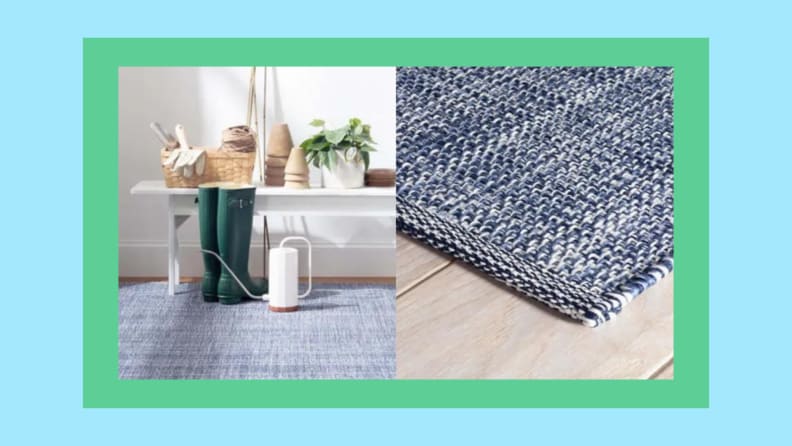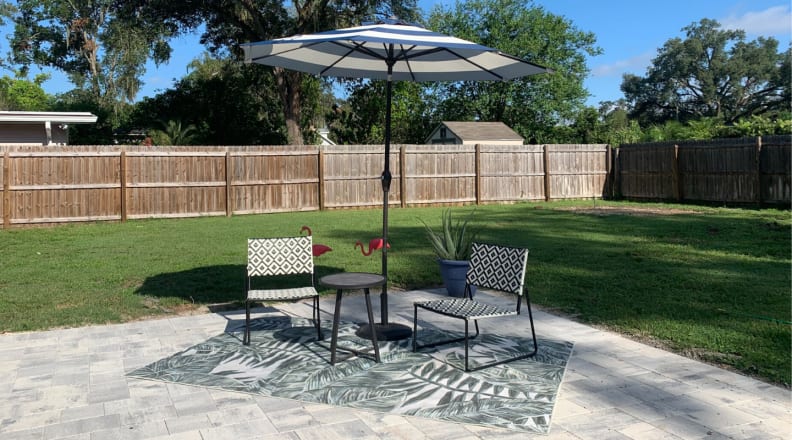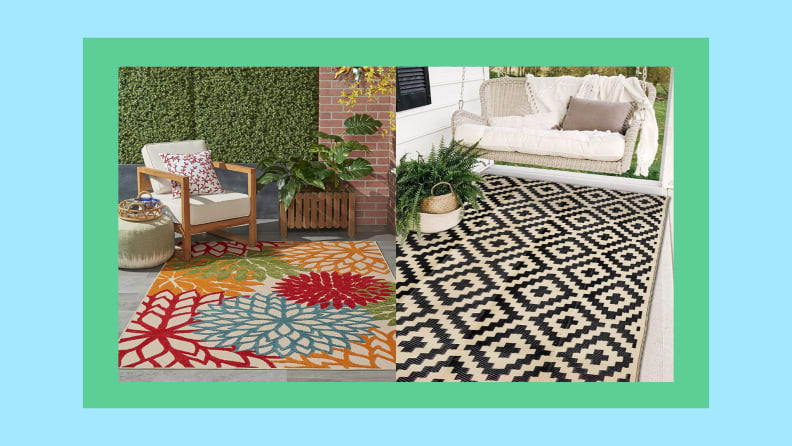Products are chosen independently by our editors. Purchases made through our links may earn us a commission.
Just as an area rug does for any room inside your home, it can also help “define” your outdoor living space. Choose the right outdoor area rug, and you bring a polished and finished look to a bare patio or deck.
Since one of the guests to your outside area is Mother Nature (hello, weather elements), not just any rug will do. We asked a few experts to weigh in on common questions about materials, patterns, and cleaning when it comes to area rugs.
Here's what to consider before buying an outdoor rug.
Material matters
“The most important element to consider when purchasing an outdoor rug is whether it is waterproof or water-resistant,” says Karen Michela Parziale of The Staging Studio in Hoboken, New Jersey. “A rug for the deck, patio, or outdoor space must be durable and weather sensitive.”
While rugs, in general, come in a variety of materials, two stand out for outdoor use: synthetic and natural. Each has its own benefits.
Polypropylene (aka olefin) is the most popular synthetic outdoor rug material. Stain- and mold-resistant, and easy to clean, it won't fade from sunlight. This type of material can also handle high moisture and heavy foot traffic.
You will find them in a variety of vibrant colors, and they can even be safely placed in direct exposure to rain. But Parziale offers a warning, “Because of its chemical makeup, it’s highly flammable. So, it’s best to keep [the rug] away from intense heat, such as fire pits or grills.”
Malka Helft likes to work with natural, plant fiber rugs, such as sisal, hemp, and seagrass. “These rugs are sustainable, extremely durable and cleanable,” explains the New York designer at Think Chic Interiors. Plant fiber rugs are usually available in more natural shades, muted tones, and gentle colorways.
Because this type of material can develop mold and mildew more easily, these rugs are ideal for a covered porch or patio.
To help with that issue, you need a rug pad to place underneath. “Rug pads are just as important for outdoor rugs as indoor rugs,” says Cindy Peterson, customer experience specialist at Room & Board, noting all types of rug could use one. “They help with air circulation and also create a buffer between the deck or concrete and help to avoid staining.”
Choose dithered over solid colors

Dithered-style rugs like this one from Annie Selke are great at hiding stains.
The rug is the most humble and lowly (literally) of your outdoor home furnishings. It gets stepped on and becomes dirty from day one. For this reason, Terry Lin suggests buying rugs in several colors. Lin co-founded Outer, a new direct-to-consumer outdoor furnishings company in Santa Monica, California.
“Find rugs that are tonal or ‘dithered,’ so stains are less apparent,” he explains. Dithered means the rug has a dominant color at a distance, but, on closer inspection, many tones make up the rug’s color, like a blue outdoor area rug from Annie Selke. “This helps with hiding dirt and extending the interval needed to clean your rug.”
Keep it clean

Ruggable's line of outdoor rugs, pictured, is machine washable for easy cleaning.
At the end of the day, outdoor rugs do get wet and dirty. There’s no way around it. But, if a rug stays wet for prolonged periods, the dirt on top of its mildew-resistant surface will grow mildew.
Unless you opt for Ruggable rugs—which are conveniently machine-washable—you'll want to pay close attention to your rug's care instructions, according to Lin.
For best results, choose an outdoor area rug that can be scrubbed down with a thick-bristled broom and an everyday cleaner. Polypropylene rugs can even be easily washed with a hose.
Select a size that suits the space
Outdoor rugs are a fun way to extend your indoor living space, so consider the size of the outdoor space just as you would an indoor room. Visually the patio or balcony should look balanced when the rug is in place.
Do you want your furniture to live completely on a rug like an island oasis? Or just have the front portions of your furniture pieces anchored on the rug? As with everything, it’s a personal preference and what feels right for the space, but Peterson suggests choosing a rug that is at least the same as the width of the sofa or chairs being used with it.
For much larger rugs, place your entire seating arrangement within the rug perimeters so the rug extends beyond the furniture anywhere from a few inches to a few feet for a cozier look and feel. “When selecting an outdoor rug for a patio table and chairs, it's best to look for a rug two feet wider than the table on all sides,” she adds.
Don’t overthink it

At the end of the day, find a rug that speaks to your personal style.
“I associate designing an outdoor space the same way you would create a flavorful meal. In every cuisine, you start with a flavor base using humble and un-fancy vegetables,” says Lin.
A rug shouldn’t dictate the design of your space, but instead, it should serve as the foundation to which you begin to build your layers of style.


